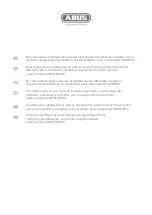
4.2 Solutions to problems
Topic: Knee
Problem
Cause
Solution
Medial and lateral socket brim
runs too far in the posterior
direction.
This squeezes the liner and the
extremity.
•
Cut socket brim so it no longer runs so far in the
posterior direction.
Prosthetic socket too tight in
a–p direction.
•
Extend a thermoplastic check socket accordingly.
•
Reduce the plaster model in the transition between
the
MPT level
and
area a
less.
Posterior socket brim too low.
Bulging because the socket brim
is too low.
Posterior socket brim too
high.
The socket brim hits the hollow
of the knee during flexion.
•
Leave the posterior (w-shaped) socket brim as high
as possible without impeding the knee flexion. Cut
out the socket brim that one finger fits in between
during 90° flexion with the flexor tendons tensed.
User wears too many long
residual limb socks.
•
If the user must wear more than one long residual
limb sock to compensate for the volume loss, a new
prosthetic socket should be made.
Relief areas are not aligned
with the knee flexor tendons.
•
Palpate the tensed knee flexor tendons and adapt
the shape of the recesses in the socket brim. The
tendons should be located in the lower area of the
recesses.
Sealing sleeve too small.
•
Select a larger sealing sleeve. The sealing sleeve
must enclose the proximal area of the prosthetic
socket and the liner tightly without impeding knee
flexion.
Plaster cast was produced
with 2-phase technique.
The condyles do not have
enough space during knee flex
ion.
•
Make a new plaster cast according to the instruc
tions of this document.
Knee flexion difficult
or bulging in the hol
low of the knee
Anterior socket edge too high.
This limits the stretching of the
sealing sleeve.
•
Form the socket brim to a height where at most the
distal third of the patella is covered.
Topic: Residual limb
Problem
Cause
Solution
Loss of vacuum.
Without
vacuum,
pistoning
occurs in the prosthetic socket,
causing skin irritation.
•
Ensure that the vacuum is generated and main
tained. Without vacuum, the user loses residual limb
volume every day.
•
Instruct the user how to check whether there is
vacuum. Instruct the user how to reestablish vacu
um.
Specific weight bearing sock
et.
High area-specific compressive
loads due to the socket shape.
•
Make a new prosthetic socket according to the
instructions of this document.
Residual limb is pulled into an
area of the prosthetic socket
without load.
•
The prosthetic socket must have contact across the
entire surface. No relief should be incorporated.
•
If possible, compensate for a volume loss with a
distal spot/half residual limb sock. Use of long sock
can cause the limb to hang proximally and create a
distal void.
Red marks on skin
The limb shifts in the liner.
•
See table section "Shifting in the liner".
Ottobock | 25
Harmony System
Tips and tricks
Содержание Harmony P3
Страница 32: ...Harmony System 32 Ottobock...
Страница 33: ...Ottobock 33 Harmony System...
Страница 34: ...Harmony System 34 Ottobock...












































